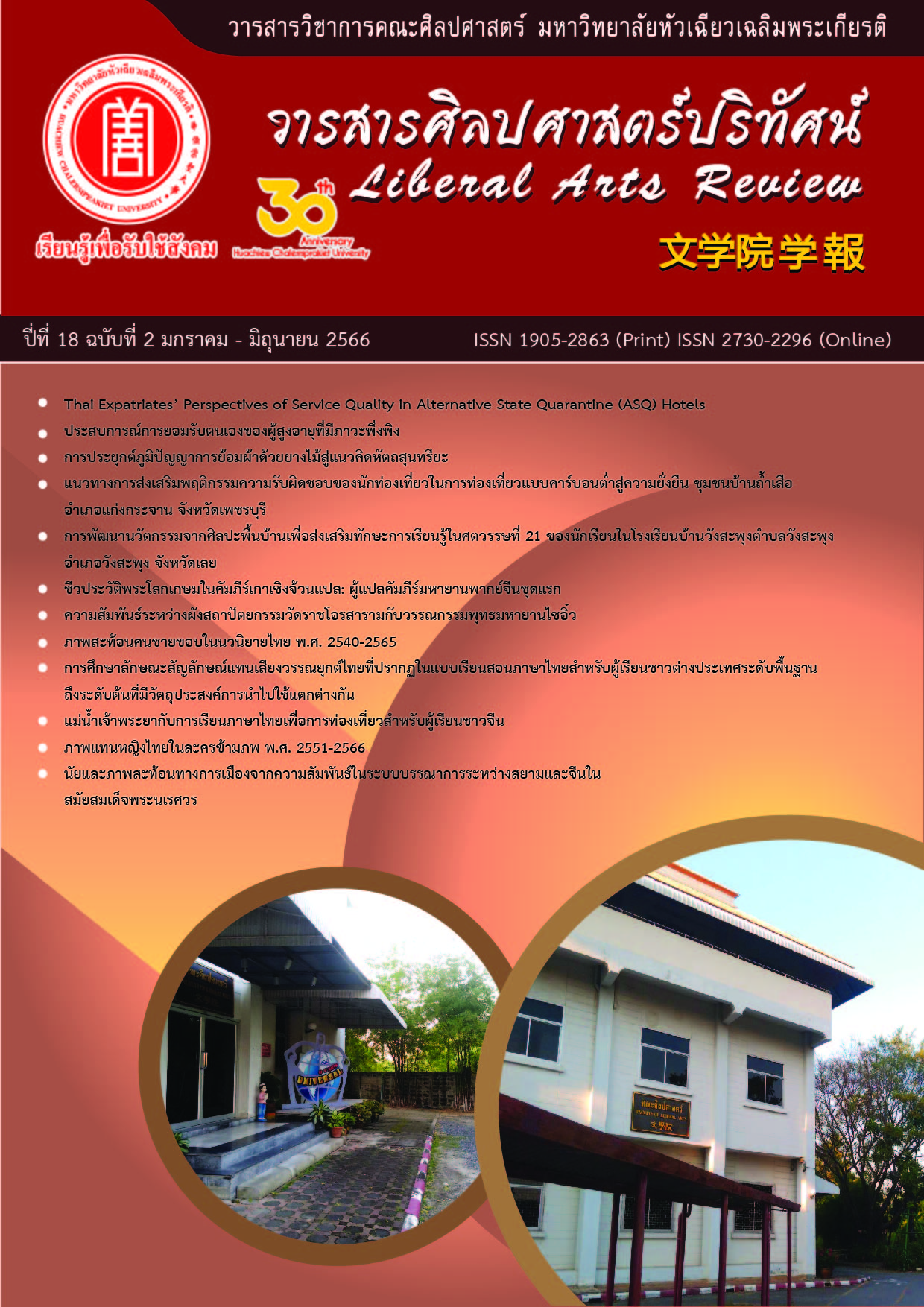The relationship between the Architectural Plans of Wat Ratcha-Orasaram and Mahayana Buddhist literature-XIYOUJI
DOI:
https://doi.org/10.14456/lar.2023.16Keywords:
Wat Ratcha-Orasaram, XIYOUJI, Mahayana Buddhism, Architectural Analysis, IconographyAbstract
This study investigates the intricate relationship between the architectural plans of Wat Ratcha-Orasaram and the Mahayana Buddhist literature, XIYOUJI. Using methods of architectural investigation and iconographic interpretation, the study reveals significant correlations between key temple elements such as Phra Ubosot, the trio of stone sculptures, Chedi Rai, the Vihara housing the reclining Buddha, the standing Buddha Vihara, and the sermon pavilion, which are accompanied by narratives from XIYOUJI. Through a detailed examination of the four principal Buddha images in accordance with the Trikaya principles and iconographic criteria, this study reveals nuanced symbolism. In the Temple's inner precinct, Kamphaeng Kaew, the reclining Buddha represents Amitabha Buddha (Sambhogakaya), while the Anantakun Buddha image in the Phra Ubosot symbolizes Sakyamuni Buddha (Nirmanakaya). While, on the Temple's outer precinct, the standing Buddha in Abhaya Mudra posture in the northern Vihara represents Amoghasiddhi Buddha (Sambhogakaya), and the Phutthachai Sitthithammanat Buddha image in the sermon pavilion is identified with Metteyya Buddha (Nirmanakaya). According to the findings, The King Rama III intended to bring all four Traditional Thai art of the principal Buddha images in accordance with Theravada Buddhism, but with hidden meanings for the Dhyani Buddha and Manusi Buddha in accordance with Mahayana Buddhism. In addition, XIYOUJI 's story was incorporated into Wat Ratcha- Orasaram 's design and decoration.
References
กรมศิลปากร. (2479). ประชุมพระราชปุจฉา ภาคปกิรณกะ. กรุงเทพมหานคร: ศรีหงส์.
กรมศิลปากร. (2565). เรื่องอนัมนิกายในสยาม. กรุงเทพมหานคร: อมรินทร์พริ้นติ้งแอนด์พับบิชชิ่ง. พิพิธภัณฑสถานแห่งชาติ พระนคร. (ม.ป.ป.). ประติมากรรมนาค 7 เศียร. ค้นคืนจาก https://www.finearts.go.th/museumbangkok/view/37721-ประติมากรรมนาค-๗-เศียร.
จรัสศรี จิรภาส. (2564). 11 ทศวรรษบันเทิงคดีไซอิ๋วสิ่งพิมพ์และวิธีวิทยาจำแนกชนิดสิ่งพิมพ์และงานแปล: ศึกษาภายใต้ กระบวนทัศน์การแพร่กระจายวรรณกรรมและวรรณกรรมกับการแปล. ศิลปศาสตร์ปริทัศน์, 16(1), 205-226.
เชษฐ์ ติงสัญชลี. (2565). มุทรา ท่าทาง เครื่องทรง สิ่งของ รูปเคารพในศาสนาพุทธ เชน ฮินดู นนทบุรี: อมรินทร์พริ้นติ้งแอนด์พับลิชชิ่ง.
ธนิต อยู่โพธิ์. (2504). ตำนานวัดราชโอรสาราม. กรุงเทพมหานคร: กรมศิลปากร.
พระมหาโกเมศ เขมธฺโม. (2525). วัดราชโอรสารามราชวรวิหาร. กรุงเทพมหานคร: กราฟิคอาร์ต.
ราชบัณฑิตยสภา. (2470). อธิบายว่าด้วยหอพระสมุดวชิรญาณแลพิพิธภัณฑสถานสำหรับพระนคร. พระนคร: โสภณพิพรรฒธนากร.
วชิรวิชญ์ ตั้งธนานุวัฒน์. (2564). การตีีความสัญลักษณ์สัตว์ทั้งสี่และประติมากรรมอื่นรอบพระเจดีย์วัดบวรนิเวศวิหารใหม่ ตามวรรณกรรมไซอิ๋ว. ดำรงวิชาการ, 21(2), 245-264.
วัดราชโอรสาราม. (2549). วัดราชโอรสาราม ราชวรวิหาร. กรุงเทพมหานคร: วัดราชโอรสาราม.
วิวัฒน์ ประชาเรืองวิทย์. (2559). ไซอิ๋ว บันทึกทัศนาจรชมพูทวีป (เล่มที่ 1-4). กรุงเทพมหานคร: ต้นไม้.
สิริเดช วังกรานต์. (2559). การศึกษาการออกแบบสถาปัตยกรรมวิหารพระนอนปางสีหไสยาสมัยต้นรัตนโกสินทร์ถึงสมัยรัชกาลที่ 4. หน้าจั่ว, 13, 260-295.
สำนักศิลปากรที่ 5. (2555). พระศรีอริยเมตไตรย: แนวคิด คติความเชื่อ และรูปแบบประติมากรรม. ปราจีนบุรี: ธุรการเจริญกิจ.
โหง่วเส่งอึง. (2547). ไซอิ๋ว พงศาวดารจีน. นนทบุรี: ศรีปัญญา.
อชิรัชญ์ ไชยพจน์พานิช. (2547). อิทธิพลศิลปะจีนในงานจิตรกรรมแบบนอกอย่างสมัยรัชกาลที่ 3 (วิทยานิพนธ์ปริญญามหาบัณฑิต). มหาวิทยาลัยศิลปากร, กรุงเทพมหานคร.
อภิเษก เทพคุณ. (2535). การศึกษาศิลปกรรมแบบพระราชนิยมในพระบาทสมเด็จพระนั่งเกล้าเจ้าอยู่หัว ณ วัดราชโอรสารามราชวรวิหาร (วิทยานิพนธ์ปริญญามหาบัณฑิต). มหาวิทยาลัยศิลปากร, กรุงเทพมหานคร.
Edmund, R. (1837). Embassy to the Eastern Courts of Cochin-China, Siam, and Muscat In the U. S. Sloop-of-war Peacock, David Geisinger, Commander, During the Years 1832-3-4. New York: Harper & Brothers.
Travis, C. M. (1995). Understanding Old Buildings: The Process of Architectural Investigation. Washington: Heritage Preservation Services.
Williams, C. A. S. (2006). Chinese Symbolism and Art Motifs (4th edition). Singapore: Tuttle Publishing.
Wu, C. E. (2012). The journey to the West (Vol. 1-4). Chicago: University of Chicago Press.
Downloads
Published
How to Cite
Issue
Section
License
Copyright (c) 2023 Liberal Arts Review

This work is licensed under a Creative Commons Attribution-NonCommercial-NoDerivatives 4.0 International License.
บทความที่ได้รับการตีพิมพ์เป็นลิขสิทธิ์ของวารสารศิลปศาสตร์วิชาการและวิจัย
ข้อความที่ปรากฏในบทความแต่ละเรื่องในวารสารวิชาการเล่มนี้เป็นความคิดเห็นส่วนตัวของผู้เขียนแต่ละท่านไม่เกี่ยวข้องกับมหาวิทยาลัยหัวเฉียวเฉลิมพระเกียรติ และคณาจารย์ท่านอื่นๆ ในมหาวิทยาลัยฯ แต่อย่างใด ความรับผิดชอบองค์ประกอบทั้งหมดของบทความแต่ละเรื่องเป็นของผู้เขียนแต่ละท่าน หากมีความผิดพลาดใดๆ ผู้เขียนแต่ละท่านจะรับผิดชอบบทความของตนเองแต่ผู้เดียว




